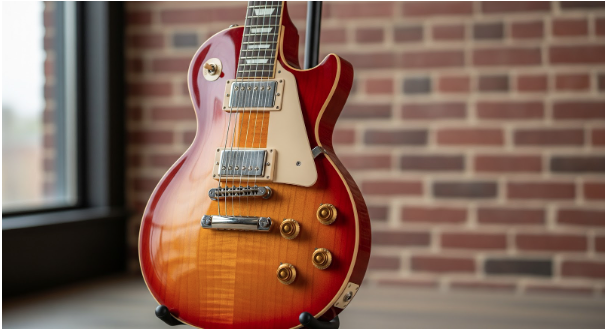
All guitarists have a time when they feel that an instrument is part of their body and not an item they are playing. That is what most people mean by the phrase that describes a guitar as “one that feels right”. Tone defines musical identity, but expression is dictated by physical connection. This relationship depends on body contouring, neck profile, spacing between frets, and balance. Ergonomically designed instruments provide confidence, and the hands are free to move across the strings without any conscious effort. The Gibson Les Paul is one of the most famous examples, as it is still used as the symbol of harmonious engineering because of its carved top, smooth neck taper and the position of the weight, combining the ease and the character.
Ergonomics Beyond Aesthetics
Form must serve function. Bending, curving of the edges, and positioning of hardware all play a role in the comfort with which wrists and elbows can be placed by the player. These minor nuances are usually not taken seriously by musicians until they are exhausted by the lengthy sessions. Proper instruments relieve the strain, giving way to chords and a flowing movement during solos.
Body Contours and Comfort Zones
Single-cut models such as the Les Paul offer good resonance, but they distribute strain by shaping edges to prevent discomfort during long playing sessions. The mass is felt in other ways with a double-cut model with easy access to higher frets. The layouts all promote a distinctive pose – some of them beckon sitting, and others prefer standing.
The Neck: Where Precision Meets Personality
The most distinctive characteristic of a guitar is the neck, used more than anything else. The easiest way is determined by the scale length, fretboard radius, and back profile, which determine the present conditions under which fingers can move on the strings. The thicker necks facilitate grip stability during rhythm work, and the slimmer shapes are used in passages that are fast and with complicated effects.
Balancing Resistance and Freedom
Excess tension results in slow articulation, and a lack of tension results in inconsistency. The balance should be ideal and responsive–loose enough to bend out riffs–and firm enough to be articulate–it is on the boundaries of the boundless. This balance gives one confidence where the players concentrate on phrasing, as compared to mechanics.
Weight and Equilibrium
The mass influences tone and feel. Heavy instruments have more sustainable effects, but this might become problematic in the long run. Light variants are more mobile at the expense of other sounds or depth. Properly balanced designs will not cause the shoulders or wrists to adjust by pushing against the body.
Standing vs. Seated Dynamics
Performance position influences perception. A guitar that sits comfortably while standing may tilt awkwardly when seated. Straps, contour angles, and horn placement all modify how weight interacts with the player’s frame. True ergonomic mastery ensures comfort in either stance.
Fretboard Flow and Hand Placement
Every millimetre matters. Fret height, edge smoothness, and string spacing determine tactile experience. Uneven surfaces or sharp fret ends interrupt focus. Rounded edges and consistent action encourage exploration, transforming practice into expression.
Fingerboard Radius and Technique
Flatter radii allow aggressive bending; curved profiles facilitate chord transitions. Matching curvature to playing style enhances ease without conscious adaptation. Precision craftsmanship ensures hands glide intuitively rather than constantly adjusting.
Tone and Tactile Response
Sound influences the perception of feel. Vibrations travelling through wood resonate differently based on construction and material density. When tactile feedback aligns with auditory expectation, playing becomes instinctive. A responsive instrument seems to anticipate each motion, translating subtle touch into immediate resonance.
Interaction Between Player and Instrument
There is a sense of confidence when a musical intention is supported with physical sensation. Streamlined fretting, constant tuning and predictable response are nothing but a form of uncertainty improved into confidence. It takes time, and monthly, muscle memory can adjust to any peculiarities of an instrument up to the moment when all movements become second nature.
Emotional Familiarity Through Design
The physical comfort later turns into emotional attachment. When one feels as though the instrument is the continuation of their will, the state of artistic fluency has started. This is accomplished by craftsmanship, but this is done at the cost of combining accuracy with human experience.
The Human Factor
Different guitars might sound different to 2 players. Personal variables are provided by anatomy, the size of the hands, and the strength of the muscles. Immediate choice of an instrument is hence less likely to go through common standards, but a very personal match that is found by trial.
Craftsmanship and Innovation
Lutherans use classic designs with improved materials and scale. Computer-controlled carving is guaranteed to be precise to the fraction of a millimetre, and ergonomic tests are run to correct contours to a naturalistic look. But the aim is the same: to invent things where the objects vanish in the hands of the player, leaving them to feel and hear the music.
Final Thoughts
A guitar should be chosen, not because it is prestigious or expensive, but because it resonates with your human instinct. The weight, curvature, texture, and proportion are gathered together in forming a harmony between hand and instrument. The Gibson Les Paul models are examples of this kind of balance – the elegant design and the mechanical perfection. Once form, sound and touch come together, the musicians go beyond technique and find the automatic ease of familiarity with their instrument that is truly personal.




